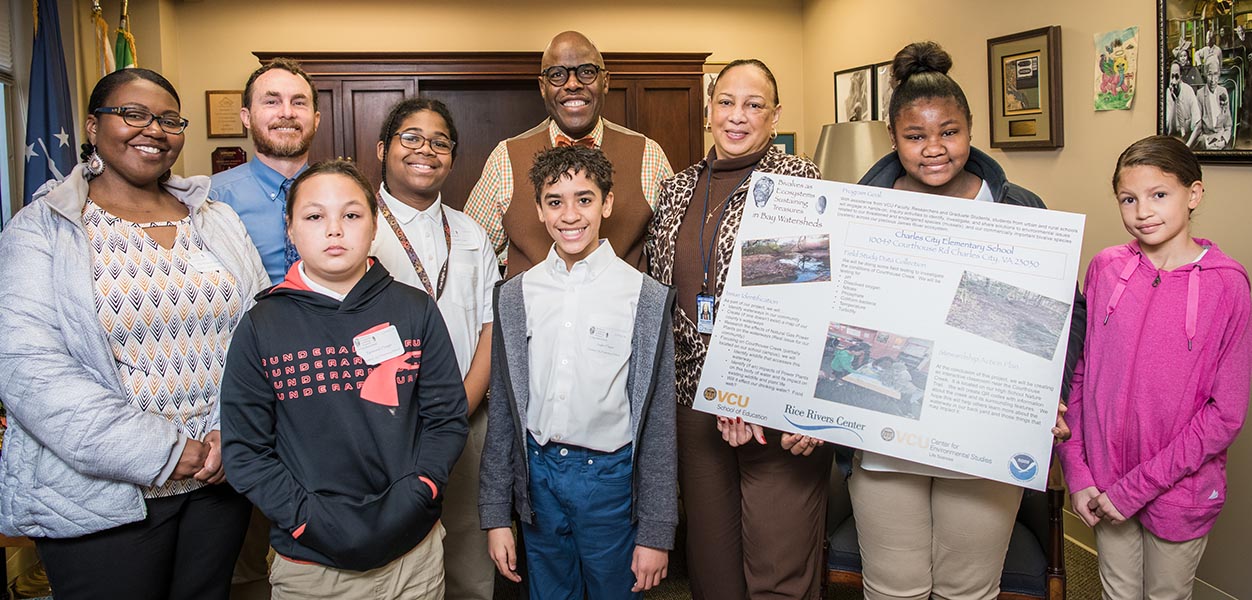Local students visit State Capitol as part of STEM grant
BEST in Bay Watersheds promotes learning outdoors and in the classroom

Student teams and teachers from four local school districts visited the Virginia State Capitol earlier this month to share with legislative representatives their progress with field investigations into local watershed ecosystems along the James River, as well as plans for future stewardship civic action projects.
The visit and field work were part of a three-year competitive grant awarded by The National Oceanic and Atmospheric Administration (NOAA) to the VCU School of Education (VCU SOE) and VCU Life Sciences titled Bivalves as Ecosystems Sustaining Treasures (BEST) in Bay Watersheds. To prepare for the initial work, teachers from the four districts – Charles City County, Colonial Heights, New Kent County and Newport News – worked side-by-side with environmental scientists, VCU Graduate students and STEM education professors from VCU last October (see photos from Day 1 and Day 2) at the VCU Rice Rivers Center.
Dr. Al Byers, interim executive director of the Center for Innovation in STEM Education and SOE STEM education visiting scholar, said that the intent of the grant is for students to conduct a Meaningful Watershed Educational Experience (MWEE), a multi-stage activity that includes learning both outdoors and in the classroom.
First, students led by their teachers determine an issue relevant to their local watershed, and then go into the field and collect data germane to the issue under investigation. Students then analyze the data, draw conclusions and use the data to design and implement a local stewardship action project in their community.
“Part of our efforts have students presenting their findings to their local legislators with the desired hope of informing future policy, legislation and funding to help sustain the critical ecosystems along the James River,” said Byers.
Dr. James Vonesh, assistant director of the VCU Center for Environmental Studies, said that the initiative will also help students understand the link between humans and endangered species in a well balanced ecosystem. “The grant specifically looks at the role of threatened and endangered species like freshwater mussels and oysters, and the important roles they play in sustaining our ecosystems, such as generating clean water, guarding against riverbed erosion, their role in natural food webs, and as commercially sustained consumer aquaculture (i.e., oysters),” Vonesh said.
Under the grant, each school is designing its own stewardship action project, each one uniquely different from the other.
Booker T. Washington Middle School in Newport News will promote oyster gardening where students will transplant oysters to an oyster reef. They will also have a workshop at their school constructing cages for the Chesapeake Bay Foundation’s oyster gardening program and share this effort via STEM awareness days at their school.
Colonial Heights Middle School collected water samples along different points of the Appomattox River and plans to increase community awareness concerning untreated stormwater that feeds directly into local waterways. Students will stencil messages on storm drain entrances to help raise awareness of how consumer activity affects the health of their local watershed and the bivalves that live there (mussels).
New Kent County Middle School will install both a rain garden and rain barrel at the school to improve innovative techniques with water quality for their stewardship action project. For the first year, sixth grade students will investigate both local and global water quality issues, and history teachers will help students learn about the Chesapeake Bay in the past, such as in John Smith’s day.
Charles City County Public Schools will be investigating Courthouse Creek near their school and the impact that planned natural gas power plants may have on their local watershed ecosystem. Students will create an interactive classroom along a nature trail near their high school adding QR codes with information about the creek and its surrounding features, thus educating others about their local waterways.
“We are excited to be assisting these schools as a joint collaboration between the School of Education, the Rice Rivers Center and the VCU Center for Environmental Studies,” said Byers.
View the Flickr Album of photos from the Virginia State Capitol visit.
Below are videos of both the House of Delegates and Senate of Virginia recognitions of student efforts.
"NOAA Grant Students at Va Assembly House" (2:29)
"NOAA Grant Students at Va Assembly Senate" (1:58)